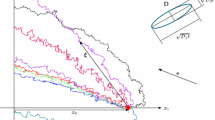Abstract
We consider the diffusion of molecules in a one-dimensional medium consisting of a large number of cells separated from the extra-cellular space by permeable membranes. The extra-cellular space is completely connected and allows unrestricted diffusion of the molecules. Furthermore, the molecules can diffuse within a given cell, i.e., the intra-cellular space; however, direct diffusion from one cell to another cell cannot occur. There is a movement of molecules across the permeable membranes between the intra- and extra-cellular spaces. Molecules from one cell can cross the permeable membrane into the extra-cellular space, then diffuse through the extra-cellular space, and eventually enter the intra-cellular space of a second cell. Here, we develop a simple set of model equations to describe this phenomenon and obtain the solutions using an eigenfunction expansion. We show that the solutions obtained using this method are particularly convenient for interpreting data from experiments that use techniques from nuclear magnetic resonance imaging.
Similar content being viewed by others
References
Basser, P. J., Mattiello, J., & LeBihan, D. (1994). MR diffusion tensor spectroscopy and imaging. Biophys. J., 66, 259–267.
Dudko, O. K., Berezhkovskii, A. M., & Weiss, G. H. (2004). Diffusion in the presence of periodically spaced permeable membranes. J. Chem. Phys., 121, 11283–11288.
Henning, E. C., Meng, X., Fisher, M., & Sotak, C. H. (2006). Visualization of cortical spreading depression using manganese-enhanced magnetic resonance imaging. Magn. Reson. Med., 53, 851–857.
Keener, J., & Sneyd, J. (1998). Mathematical physiology. New York: Springer.
Kuchel, P. W., & Durrant, C. J. (1999). Permeability coefficients from NMR q-space data: Models with unevenly spaced semi-permeable parallel membranes. J. Magn. Reson., 139, 258–272.
Kuchel, P. W., Eykyn, T. R., & Regan, D. G. (2004). Measurement of compartment size in q-space experiments: Fourier transform of the second derivative. Magn. Reson. Med., 52, 907–912.
Minematsu, K., Li, L., Sotak, C. H., Davis, M. A., & Fisher, M. (1992). Reversible focal ischemic injury demonstrated by diffusion-weighted magnetic resonance imaging in rats. Stroke, 23, 1304–1310.
Miura, R. M., Huang, H., & Wylie, J. J. (2007). Cortical spreading depression: an enigma. Eur. Phys. J., Spec. Top., 147, 287–302.
Murad, M. A., Bennethum, L. S., & Cushman, J. H. (1995). A multi-scale theory of swelling porous media: I. Application to one-dimensional consolidation. Transp. Porous Media, 19, 93–122.
Powles, J. G., Mallett, M. J. D., Rickayzen, G., & Evans, W. A. B. (1992). Exact analytic solutions for diffusion impeded by an infinite array of partially permeable barriers. Proc. R. Soc. Lond. A, 436, 391–403.
Shapiro, B. E. (2000). An electrophysiological model of gap-junction mediated cortical spreading depression including osmotic volume changes. Ph.D. Thesis, UCLA.
Tanner, J. E. (1978). Transient diffusion in a system partitioned by permeable barriers. Application to NMR measurements with a pulsed field gradient. J. Chem. Phys., 69, 1748–1754.
Tuckwell, H. C., & Miura, R. M. (1978). A mathematical model for spreading cortical depression. Biophys. J., 23, 257–276.
van der Weerd, L., Melnikov, S. M., Vergeldt, F. J., Novikov, E. G., & Van As, H. (2002). Modelling of self-diffusion and relaxation time NMR in multicompartment systems with cylindrical geometry. J. Magn. Reson., 156, 213–221.
von Meerwall, E., & Ferguson, R. D. (1981). Interpreting pulsed-gradient spin-echo diffusion experiments with permeable membranes. J. Chem. Phys., 74, 6956–6959.
Whitaker, S. (1999). The method of volume averaging (theory and applications of transport in porous media). The Netherlands: Kluwer Academic.
Wylie, J. J., & Miura, R. M. (2006). Traveling waves in coupled reaction-diffusion models with degenerate sources. Phys. Rev. E, 74, 021909.
Wylie, J. J., Huang, H., & Miura, R. M. (2009). Systems of coupled diffusion equations with degenerate nonlinear source terms: linear stability and traveling waves. Discrete Contin. Dyn. Syst., Ser. A, 23, 561–569.
Author information
Authors and Affiliations
Corresponding author
Rights and permissions
About this article
Cite this article
Huang, H., Wylie, J.J. & Miura, R.M. Restricted Diffusion in Cellular Media: (1+1)-Dimensional Model. Bull Math Biol 73, 1682–1694 (2011). https://doi.org/10.1007/s11538-010-9589-1
Received:
Accepted:
Published:
Issue Date:
DOI: https://doi.org/10.1007/s11538-010-9589-1




